
Wassily Wassilyevich Kandinsky was a Russian painter and art theorist. Kandinsky is generally credited as one of the pioneers of abstraction in western art. Born in Moscow, he spent his childhood in Odesa, where he graduated from Odesa Art School. He enrolled at the University of Moscow, studying law and economics. Successful in his profession—he was offered a professorship at the University of Dorpat —Kandinsky began painting studies at the age of 30.

Socialist realism is a style of idealized realistic art that was developed in the Soviet Union and was the official style in that country between 1932 and 1988, as well as in other socialist countries after World War II. Socialist realism is characterized by the depiction of communist values, such as the emancipation of the proletariat. Despite its name, the figures in the style are very often highly idealized, especially in sculpture, where it often leans heavily on the conventions of classical sculpture. Although related, it should not be confused with social realism, a type of art that realistically depicts subjects of social concern, or other forms of "realism" in the visual arts. Socialist realism was made with an extremely literal and obvious meaning, usually showing an idealized USSR. Socialist realism was usually devoid of complex artistic meaning or interpretation.

In the arts and in literature, the term avant-garde identifies a genre of art, an experimental work of art, and the experimental artist who created the work of art, which usually is aesthetically innovative, whilst initially being ideologically unacceptable to the artistic establishment of the time. The military metaphor of an advance guard identifies the artists and writers whose innovations in style, form, and subject-matter challenge the artistic and aesthetic validity of the established forms of art and the literary traditions of their time; thus how the artists who created the anti-novel and Surrealism were ahead of their times.

Nose art is a decorative painting or design on the fuselage of an aircraft, usually on the front fuselage.
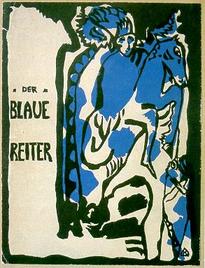
Der Blaue Reiter is a designation by Wassily Kandinsky and Franz Marc for their exhibition and publication activities, in which both artists acted as sole editors in the almanac of the same name, first published in mid-May 1912. The editorial team organized two exhibitions in Munich in 1911 and 1912 to demonstrate their art-theoretical ideas based on the works of art exhibited. Traveling exhibitions in German and other European cities followed. The Blue Rider disbanded at the start of World War I in 1914.

Ilya Yefimovich Repin was a Ukrainian-born Russian painter. He became one of the most renowned artists in Russia in the 19th century. His major works include Barge Haulers on the Volga (1873), Religious Procession in Kursk Province (1880–1883), Ivan the Terrible and His Son Ivan (1885); and Reply of the Zaporozhian Cossacks (1880–1891). He is also known for the revealing portraits he made of the leading Russian literary and artistic figures of his time, including Mikhail Glinka, Modest Mussorgsky, Pavel Tretyakov, and especially Leo Tolstoy, with whom he had a long friendship.

Ernst Heinrich Barlach was a German expressionist sculptor, medallist, printmaker and writer. Although he was a supporter of the war in the years leading to World War I, his participation in the conflict made him change his position, and he is mostly known for his sculptures protesting against the war. This created many conflicts during the rise of the Nazi Party, when most of his works were confiscated as degenerate art. Stylistically, his literary and artistic work would fall between the categories of twentieth-century Realism and Expressionism.
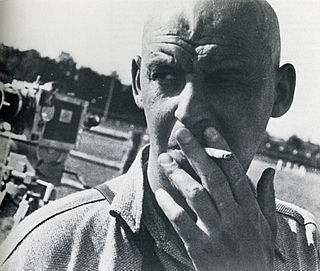
Aleksander Mikhailovich Rodchenko was a Russian and Soviet artist, sculptor, photographer, and graphic designer. He was one of the founders of constructivism and Russian design; he was married to the artist Varvara Stepanova.

Mir iskusstva was a Russian magazine and the artistic movement it inspired and embodied, which was a major influence on the Russians who helped revolutionize European art during the first decade of the 20th century. The magazine had limited circulation outside Russia.
Palekh miniature is a Russian folk handicraft of a miniature painting, which is done with tempera paints on varnished articles made of papier-mâché.
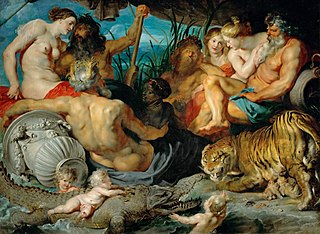
A work of art, artwork, art piece, piece of art or art object is an artistic creation of aesthetic value. Except for "work of art", which may be used of any work regarded as art in its widest sense, including works from literature and music, these terms apply principally to tangible, physical forms of visual art:

Kuzma Sergeevich Petrov-Vodkin, was a Russian and Soviet painter. His early iconographic work used special creative effects based on the curve of the globe, but its images were considered blasphemous by the Russian Orthodox Church. However he went on to become the first president of the Leningrad Union of Soviet Artists. His autobiographical writings attracted much praise, and have enjoyed a later revival.
Painting – artwork in which paint or other medium has been applied to a surface, and in which area and composition are two primary considerations.
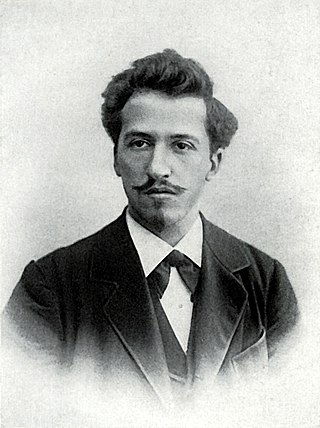
Pieter Cornelis Mondriaan, after 1906 known as Piet Mondrian, was a Dutch painter and art theoretician who is regarded as one of the greatest artists of the 20th century. He is known for being one of the pioneers of 20th-century abstract art, as he changed his artistic direction from figurative painting to an increasingly abstract style, until he reached a point where his artistic vocabulary was reduced to simple geometric elements.
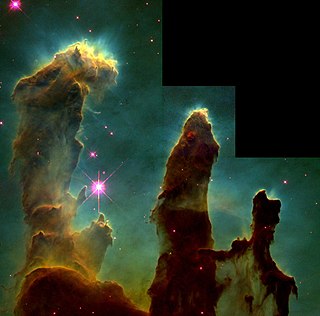
"Space art", also known as "astronomical art", is the term for a genre of modern artistic expression that uses the universe as a frame of reference. Like other genres, space art has many facets and encompasses realism, impressionism, hardware art, sculpture, abstract imagery, and zoological art. Though artists have long produced art with astronomical elements, the genre of space art itself is still in its infancy, having begun only when technological advancement allowed for more detailed observation of the night sky. Regardless of style, space art generally attempts to communicate ideas somehow related to space, often including an artistic interpretation of varied cosmological phenomena and scientific discoveries. In some cases, artists who consider themselves space artists use more than illustration and painting to communicate astronomy or works depicting space, with some working directly with space flight technology and scientists in attempts to expand the arts, humanities, and cultural expression relative to space exploration.

El Cap de Barcelona (1991–1992) is a surrealist sculpture created by American Pop artist Roy Lichtenstein for the 1992 Summer Olympics in Barcelona, Catalonia, Spain. Its English title is The Head of Barcelona.

Marat Aleksandrovich Gelman is a Russian collector, gallerist, and an op-ed columnist. The former director of PERMM contemporary art museum in Perm. The deputy director of Channel One from June 2002 to February 2004. A political consultant, a co-founder of the Foundation for Effective Politics, and a member of Russia's Public Chamber.

Realism was an artistic movement that emerged in France in the 1840s, around the 1848 Revolution. Realists rejected Romanticism, which had dominated French literature and art since the early 19th century. Realism revolted against the exotic subject matter and the exaggerated emotionalism and drama of the Romantic movement. Instead, it sought to portray real and typical contemporary people and situations with truth and accuracy, and not avoiding unpleasant or sordid aspects of life. The movement aimed to focus on unidealized subjects and events that were previously rejected in art work. Realist works depicted people of all classes in situations that arise in ordinary life, and often reflected the changes brought by the Industrial and Commercial Revolutions. Realism was primarily concerned with how things appeared to the eye, rather than containing ideal representations of the world. The popularity of such "realistic" works grew with the introduction of photography—a new visual source that created a desire for people to produce representations which look objectively real.

Růžena Zátková, also called Rougina Zatkova, was a painter and sculptor who has been regarded as the "only authentic Czech futurist." As a result of her Bohemian heritage and her decade-long residency in Rome, Růžena Zátková became an important artistic link between Russian and Italian Futurism. Zátková is considered one of the pioneers of kinetic art.

Portrait of Ambroise Vollard is an oil-on-canvas painting by Pablo Picasso, which he painted in 1910. It is now housed in the Pushkin Museum in Moscow. The painting is a representation of the influential art dealer Ambroise Vollard, who played an important role in Picasso's early career as an artist. It is painted in the style of Analytical Cubism, which Picasso pioneered.

















